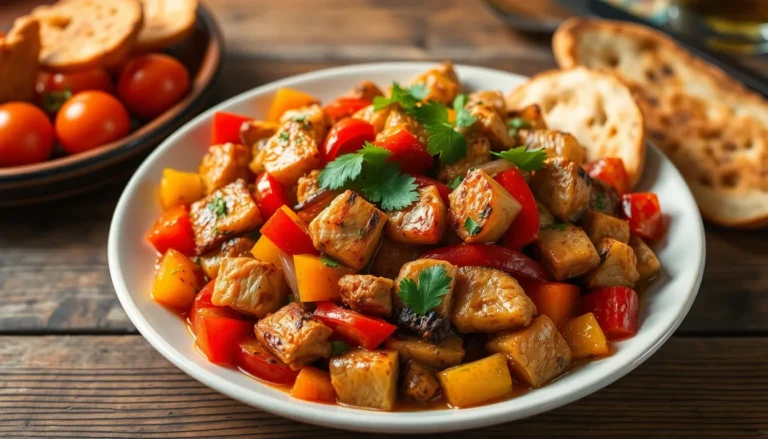Table of Contents
ToggleGetting nutritious meals into preschoolers can be a challenge, but it doesn’t have to be boring. Creative preschool meal ideas can transform mealtime into an exciting adventure for little ones. With vibrant colors and fun shapes, these meals not only please picky eaters but also ensure they’re getting the vitamins and minerals they need for healthy growth.
Parents and caregivers can easily whip up a variety of dishes that are both appealing and nutritious. From playful fruit kabobs to colorful veggie wraps, the possibilities are endless. By incorporating diverse ingredients and flavors, mealtime becomes an opportunity for exploration and learning, setting the stage for healthy eating habits that last a lifetime.
Overview of Preschool Meal Ideas
Providing diverse and nutritious meal ideas for preschoolers enhances their mealtime experience. Engaging dishes can help cultivate healthy eating habits while ensuring essential nutrients. Colorful fruits and vegetables make meals visually appealing, encouraging children to try new foods.
Meal Categories
- Fruits
- Fresh fruits like strawberries, bananas, and grapes offer essential vitamins.
- Dried fruits, such as apricots and raisins, serve as healthy snacks.
- Vegetables
- Raw vegetables, including carrots, cucumber, and bell peppers, provide crunchy textures.
- Cooked veggies like sweet potatoes and broccoli contribute vital minerals.
- Grains
- Whole grain options, such as brown rice and whole wheat bread, support energy needs.
- Oatmeal is a nutritious breakfast choice that promotes fullness.
- Proteins
- Lean proteins like chicken, turkey, and fish offer essential amino acids.
- Plant-based proteins from beans, lentils, and tofu provide variety.
- Dairy
- Low-fat yogurt and cheese provide calcium for growing bones.
- Milk remains a staple drink, supplying necessary vitamins.
Fun Meal Ideas
- Fruit Kabobs
- Assemble colorful skewers with a mix of fruits for a fun, hands-on experience.
- Veggie Wraps
- Encourage preschoolers to fill tortillas with an array of vegetables and spreads.
- Mini Pizzas
- Use whole grain pitas or English muffins as a base, allowing kids to customize toppings.
- Smoothie Bowls
- Blend fruits with yogurt, topped with granola and seeds for added crunch.
- Animal-Shaped Sandwiches
- Use cookie cutters to create sandwiches shaped like animals, sparking interest.
Incorporating these meal ideas can make mealtime a delightful experience while supporting preschoolers’ nutritional needs.
Nutritional Requirements for Preschoolers


Preschoolers require specific nutrients for healthy growth and development. Understanding these needs ensures that meals provide balanced nutrition for active young children.
Key Nutrients for Growth
- Proteins: Proteins support muscle development and repair tissues. Include sources such as eggs, lean meats, beans, and dairy products.
- Carbohydrates: Carbohydrates provide energy for daily activities. Incorporate whole grains, fruits, and vegetables as primary carbohydrate sources.
- Fats: Essential fats aid in brain development. Use healthy fats from avocados, nuts, seeds, and olive oil in meals.
- Vitamins: Vitamins A, C, and D are crucial for vision, immune function, and bone health, respectively. Fruits, vegetables, and fortified dairy products are great choices.
- Minerals: Iron and calcium are vital. Iron-rich foods include red meat and leafy greens, while dairy products and fortified alternatives supply calcium.
Portion Sizes to Consider
- Fruits and Vegetables: Offer 1 to 1.5 cups of fruits and 1 to 1.5 cups of vegetables daily. Cut portions into small, manageable pieces to encourage consumption.
- Grains: Serve 3 to 5 ounces of grains per day, prioritizing whole grains. Small servings of items like whole-grain pasta or bread promote satiety.
- Proteins: Provide 2 to 4 ounces of protein-rich foods daily. Serve options like chicken, fish, or legumes in child-sized portions.
- Dairy: Aim for 2 to 2.5 cups of dairy products each day. Use low-fat or non-fat options to meet calcium needs without excess saturated fat.
Using these guidelines helps create nutritious, well-balanced meals that support preschoolers’ growth and health.
Creative Preschool Meal Ideas
Creative meal ideas make eating enjoyable for preschoolers while providing essential nutrients. Here are some appealing options for breakfast, lunch, and snacks.
Breakfast Options
- Fruit and Yogurt Parfaits: Layer low-fat yogurt, granola, and colorful fruits like blueberries and strawberries for a visually appealing start to the day.
- Mini Whole Grain Pancakes: Serve bite-sized pancakes topped with fruit slices or a drizzle of honey, making them easy for little hands to hold.
- Egg Muffins: Whisk eggs with diced vegetables and cheese, pour into muffin tins, and bake for a nutritious grab-and-go breakfast option.
- Oatmeal Bowls: Offer oatmeal topped with bananas, cinnamon, and nuts, promoting creativity with various toppings.
- Smoothie Packs: Blend fruits and leafy greens, pour into cups, and freeze for a quick, nutrient-packed breakfast on busy mornings.
Lunch Ideas
- DIY Mini Pizzas: Provide whole wheat English muffins, tomato sauce, and a range of toppings, allowing children to create their own personal pizzas.
- Colorful Wraps: Use whole grain tortillas and fill them with turkey, cheese, and assorted veggies, encouraging children to pick their favorite fillings.
- Animal-shaped Sandwiches: Make sandwiches using cookie cutters in fun shapes; fill them with proteins like ham or peanut butter to increase appeal.
- Vegetable Sushi Rolls: Roll sushi rice and vegetables in seaweed for a fun, nutritious lunch that introduces new flavors.
- Pasta Salad: Combine whole grain pasta with olives, cheese, and cherry tomatoes, offering a refreshing and visually appealing meal option.
Snack Suggestions
- Fruit and Nut Trail Mix: Mix dried fruits, nuts, and whole grain cereal for a healthy, energy-boosting snack that’s easy to prepare.
- Veggie Sticks with Hummus: Offer colorful veggie sticks like carrots and cucumbers alongside hummus for dipping, promoting healthy snacking habits.
- Cheese Cubes and Whole Grain Crackers: Pair cheese cubes with whole grain crackers for a satisfying snack rich in protein and fiber.
- Frozen Yogurt Bites: Dollop yogurt on a baking sheet, freeze, and serve as a cool treat on warmer days.
- Popcorn: Air-popped popcorn seasoned lightly with salt provides a whole grain snack that kids can enjoy while watching their favorite show.
Tips for Meal Prep and Planning
Effective meal prep simplifies the process of providing nutritious food for preschoolers. Implementing these strategies enhances both creativity and enjoyment during mealtime.
Involving Children in Meal Prep
Involving children in meal prep cultivates their interest in food and teaches important skills. Engaging them in age-appropriate tasks fosters excitement for healthy choices.
- Encourage them to wash fruits and vegetables. This simple task promotes cleanliness and introduces them to raw food textures.
- Allow selection of fruits and vegetables during grocery shopping. Children become more invested in meals when they help choose ingredients.
- Assign mixing or assembling roles, such as creating their own wraps or assembling fruit kabobs. This hands-on approach encourages creativity and experimentation.
- Teach basic knife skills with child-safe utensils for safely cutting soft fruits. Learning to use kitchen tools develops confidence and independence.
Batch Cooking for Busy Days
Batch cooking streamlines meal preparation and provides balanced options throughout the week. This technique saves time and minimizes stress for parents and caregivers.
- Cook grains like quinoa, brown rice, or pasta in larger quantities. Storing these staples allows for quick side dishes or base layers in various meals.
- Prepare proteins by cooking chicken, beans, or tofu in bulk. These proteins can be added to salads, wraps, or mixed with grains for versatile meals.
- Chop and store vegetables for salads or stir-fries ahead of time. Prepped veggies increase the likelihood of incorporating colorful options at mealtime.
- Make freezer-friendly meals, such as soups or casserole dishes, in larger portions. This strategy offers an easy, nutritious option on busy days.







